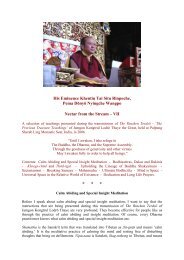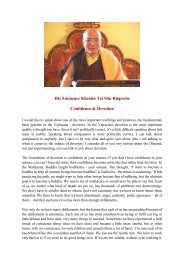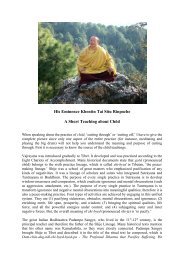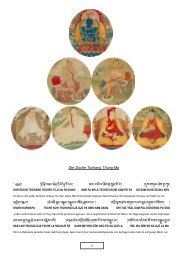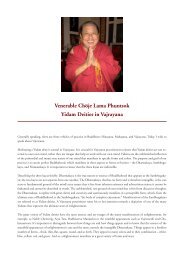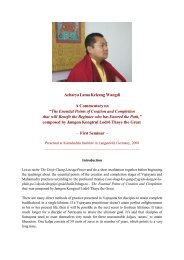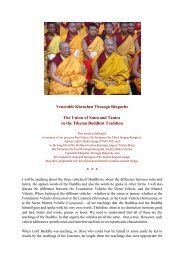Acharya Lama Kelzang Wangdi White Arya Tara - Karma Sherab Ling
Acharya Lama Kelzang Wangdi White Arya Tara - Karma Sherab Ling
Acharya Lama Kelzang Wangdi White Arya Tara - Karma Sherab Ling
You also want an ePaper? Increase the reach of your titles
YUMPU automatically turns print PDFs into web optimized ePapers that Google loves.
we can’t expect that the noodles we have in Italy taste the same when we have them in<br />
Germany. The mudras vary according to the Old Tradition and the New Tradition of<br />
Buddhism in Tibet. The New Tradition arose because some people didn’t trust the Old<br />
Tradition and travelled to India to receive the genuine teachings of the Buddha that existed in<br />
India. They learned Sanskrit, practiced the instructions, and founded the New Tradition. The<br />
<strong>White</strong> <strong>Tara</strong> Sadhana that we are practicing belongs to the New Tradition.<br />
Student: “In the Christian tradition, people returned to the writings of the old masters and<br />
inaugurated the Renaissance.”<br />
<strong>Lama</strong> <strong>Kelzang</strong>: Yes, it’s similar. People doubted whether the teachings of the Old Tradition<br />
were the genuine teachings of the Buddha. So they went to India and translated the Sanskrit<br />
texts, which were the root teachings of the Buddha.<br />
We carry out the mudras to make the meaning clearer. The mudras in the <strong>White</strong> <strong>Tara</strong> practice<br />
can’t be compared to those in the Green <strong>Tara</strong> practice. They also differ in the Old and New<br />
Traditions, which we commonly use. It depends on the Transmission Lineage. For example, if<br />
you are German, you think, act, and speak in a German way. It’s impossible to copy people<br />
from other countries. We can’t talk like the French, otherwise we get difficulties with<br />
ourselves. In that way, the mudras differ.<br />
(After having repeatedly practiced the mudras with the group, <strong>Lama</strong> <strong>Kelzang</strong> explained the<br />
mantra of <strong>White</strong> <strong>Tara</strong> and the specific mudra that closes this section of the practice and<br />
jokingly said:) It’s <strong>Tara</strong> tai-chi.<br />
There are three qualities of deity yoga meditation that are very important. One is visualizing<br />
the image very clearly in our mind. For example, when we imagine our home, we have a clear<br />
picture of it in our mind. Our visualization should be just as clear, which is the clarity aspect<br />
of meditation. (<strong>Lama</strong> <strong>Kelzang</strong> explained the visualization practice and reminded us that we<br />
have to practice step by step. He said that it would be like not knowing where we are going if<br />
our visualization isn’t clear. Furthermore:) The second aspect is having the vajra pride of<br />
really being <strong>White</strong> <strong>Tara</strong>, otherwise we aren’t sure but just think it. Then it doesn’t work and<br />
the situation is like a tape recorder playing the text for us.<br />
Student: “Should we be clear that <strong>Tara</strong> is like the sun and moon, the aspects of wisdom and<br />
compassion?”<br />
<strong>Lama</strong> <strong>Kelzang</strong>: No, the aspect of clarity means having a clear image in our mind, the first<br />
aspect. The second aspect is having vajra pride.<br />
Translator: “We often feel miserable and think that we aren’t very nice.”<br />
<strong>Lama</strong> <strong>Kelzang</strong>: Yes, those are bad concepts. You have to drop such concepts. That’s why we<br />
practice, otherwise it’s pointless. We meditate to break our old concepts that don’t work to<br />
feel the peace that we really are. We don’t think, “I’m so bad,” rather, now we think, “I’m<br />
<strong>White</strong> <strong>Tara</strong>.” Meditation isn’t an imagination or an exaggeration, rather, it strengthens us to<br />
trust ourselves as we are and to have confidence.<br />
(In the answer to a question about practice, <strong>Lama</strong> <strong>Kelzang</strong> taught:) The aim of meditation is<br />
to transform our usual way of seeing ourselves. It’s very important to understand that the<br />
deity isn’t a substantial reality, but we practice to break our old concepts that make things<br />
very complicated and mixed up. It’s very important to understand that we are breaking our<br />
usual concepts.<br />
When we engage in deity yoga, we need to have the view of emptiness, otherwise our practice<br />
becomes a little bit funny. Having the view of emptiness means we are impartial. Emptiness<br />
doesn’t mean a bowl is empty of water, for example, rather, it means being free of dualistic<br />
12



